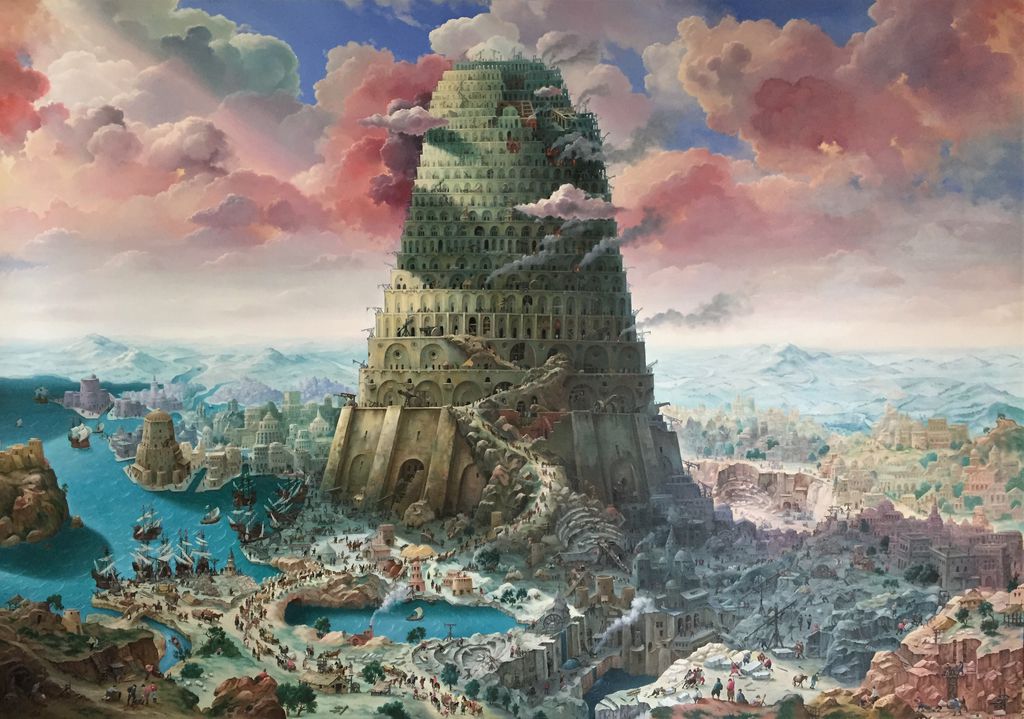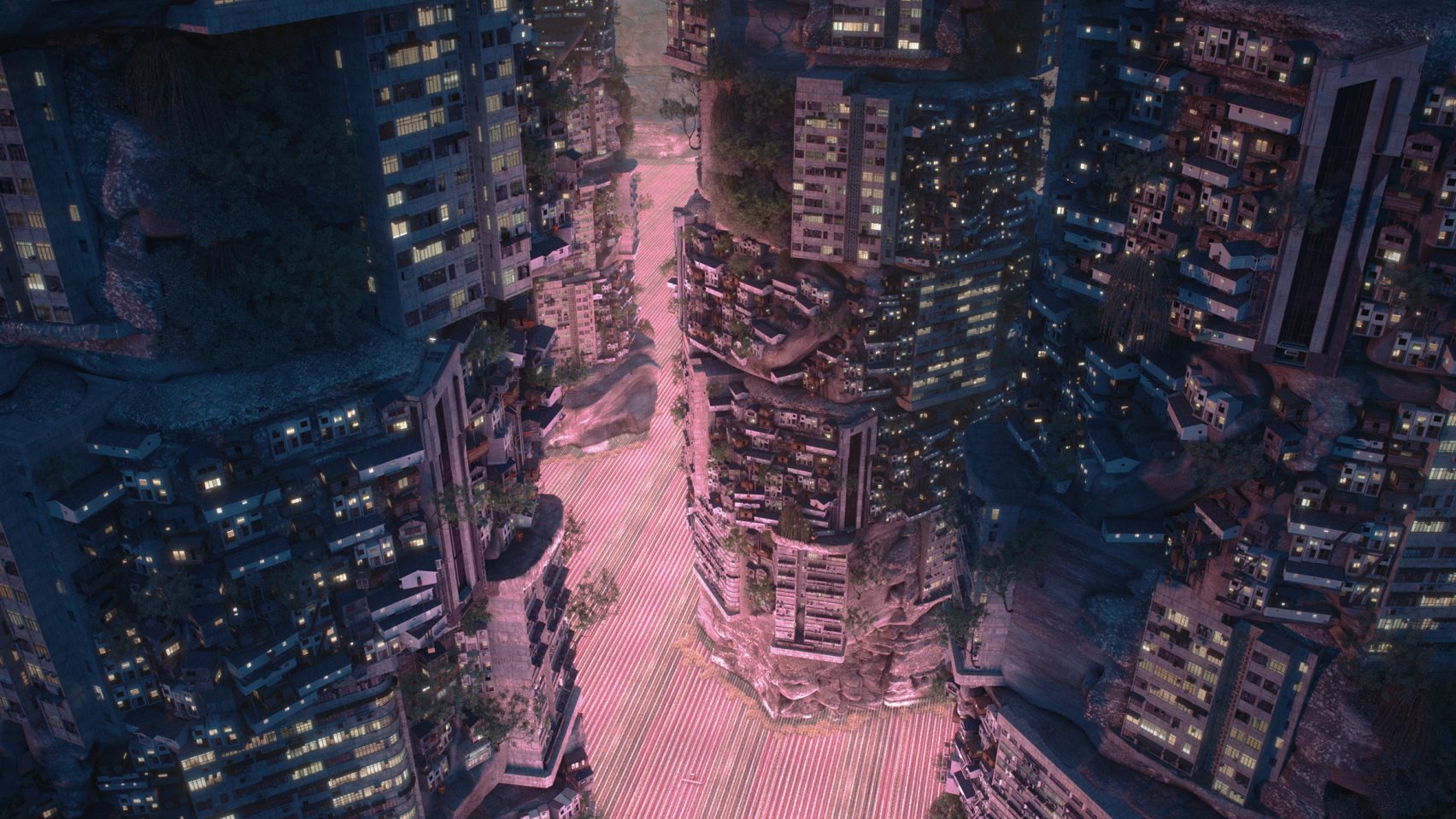Welcome to Planet City
Investing in critical arts-based enquiry, research and storytelling is crucial to the future of the arts. Our inaugural ANAT Emerging Writer Series launches with a series of five features by newly appointed ANAT Arts Administrator and emerging writer Aushaf Widisto. Surveying SPECTRAvision, Aushaf begins by introducing Episode 1: Assembly for the Future Live from Planet City 2029.

Alexander Mikhalchyk, The Tower of Babel, 2019. Licensed under CC BY-SA 4.0.
SPECTRAvision Episode 1: Assembly for the Future Live from Planet City 2029
What would happen if, in the not-so-distant future, the entirety of mankind were to live in a single city?
That was the premise of Planet City, a project led by Liam Young, an Australian-born and LA-based speculative architect and filmmaker. Planet City was featured in the first episode of SPECTRAvision, as a digital gathering titled Assembly for the Future, which went live on Friday, 25 March 2022–but would supposedly bring us into 2029, to witness and discuss what’s become of our beloved Earth after its planet-wide urban centralisation.
Assembly for the Future was the opening act of curator David Pledger’s iteration of ANAT SPECTRA, which consists of six episodes: SPECTRAvision’s five online episodes and SPECTRAlive’s three-day in-person gathering in Melbourne.
At the time, I had just joined the ANAT team as an arts administrator, and Assembly for the Future was my very first experience with ANAT. This is what I’ve learned from the discussion.
Welcome to Planet City
First, let’s briefly go into what Planet City is.
Liam described it as a “radical reversal of planetary sprawl,” where 10 billion people withdraw from our colossal network of cities and move into one hyper-dense metropolis housing the entire population of the earth.
This mass exodus was inspired by E. O. Wilson, the American biologist, and his idea of the “half-earth”–where humankind occupies only one half of planet Earth and leaves the other half completely to nature.
Essentially, Planet City takes this half-earth idea to the furthest extreme–it divides, not only one half with another half, but one city with everywhere else.
When the world is condensed and centralised into a single city, the rest of the planet is then left to rewild. Floras and faunas will prosper without human presence, and ultimately, this will create a more sustainable ecosystem. We will mine our old cities instead of virgin ground. We will no longer need a worldwide shipping fleet to acquire our sustenance. Energy will be produced and consumed in full circularity. Natural resources will be preserved. Eventually, our young will take back the future that has been stolen from them.
Sounds like a dream. But would it be possible to bring Planet City into reality?

Liam Young, ‘Planet City’, 2020, (still), colour digital video, sound, 15 min. Commissioned by the National Gallery of Victoria, Melbourne.
Through the Eyes of an Urbanist
I happened to major in Urban Planning during my undergraduate studies, and although I don’t currently work as an urbanist, the knowledge and concepts I’ve learned are still there somewhere in my brain–and participating in Assembly for the Future prompted me to recall that past life.
So I thought, let’s play make-believe. What if I was the urbanist in charge of planning Planet City?
Cities are complex systems, and urban planning is in turn a multifaceted discipline. When planning a city, an urbanist must consider a whole host of intricate and entangled elements.
Off the top of my head, this is what I imagined:
- Planet City’s land use must be mixed-use. With that extreme population density, all urban functions must be located within close proximity to be able to function efficiently–akin to Carlos Moreno’s “15-minute city,” where most essential functions (e.g. living, working, commerce, education, healthcare) are located within a 15-minute walk or bike ride.
- Its housing must be high-rise. With 10 billion people living in a limited amount of land, the only direction to expand is vertical. Liam illustrated this in the Planet City film, where we see units of housing stacked on top of each other, forming structures tall enough to reach the heavens, much like the biblical Tower of Babel. Additionally, if need be we might extend our development downwards, forming a network of subterranean hubs and tunnels.
- Its transportation must be public. In a city so dense, there simply won’t be room for 10 billion private cars. And since our buildings are all high-rise, we must consider both horizontal and vertical transportation. Perhaps, we could use a network of multidirectional elevators or a fleet of hovercrafts.
- Its infrastructure systems must be integrated seamlessly. There are many kinds of infrastructures: electricity, telecommunications, water, waste management, and so on. Elaborating on all of them would take more than one article, but a unifying point is that all infrastructures must be widely available and easily accessible to ensure fair quality of life across the city.
…at least that’s what I came up with, as a wannabe urbanist. And let’s not forget, we’ve only been talking about the city itself. There’s still the rest of the planet, which has been left to rewild. Surely, this newfound wilderness needs some planning too, doesn’t it? We must ensure the city and the wild exist in symbiosis.
But we’re now moving beyond the scope of urbanism, so we need to ask other experts.
Luckily, at Assembly for the Future, we happened to have two.
Humans Above and the Mycelium Underneath
At Assembly for the Future, we had two extraordinary respondents expanding upon Liam’s provocation.
The first is the Nobel Laureate, Professor Peter Doherty, who expressed that Planet City would work great with a circular economy since everybody is squeezed so close together. Although, he also expressed that instead of one hyper-dense city for 10 billion people, it would be more realistic to make a network of globally interlinked cities.
The reason for that is twofold. One, the climate cost of bringing everything together would be too massive. And two, as we consume resources, we also produce waste–and that waste must be put out there. This implies that we can’t just leave the world outside the city to rewild itself–we have to manage that rewilding.
But say we do decide to congregate in a single city. As a species, we have shared visions and responsibilities, and living inside one border will make that feel more real than ever before. That means we’re going to have to reassess our values. Eventually, we’ll learn to appreciate things that sustain life, like nutritious vegetables, for instance, instead of exotic sports cars. This is a long-overdue realization.
The second respondent is Nyikina Warrwa Custodian, Dr Anne Poelina a.k.a. AP1957 of the Ancient Ones, who presented a rather bleak picture of Planet City: one where a cabal of predatory elites rules the city top-down, controlling the masses with an army of AI-powered robot police. Their tyranny would turn Planet City into an Orwellian state, and their misogyny toward Mother Earth would compromise even the wilderness beyond.
Through that cautionary tale, she emphasised the importance of ancient cultures and stories. Our predecessors, both distant and immediate, have accumulated a massive and ever-growing repertoire of wisdom that we could draw from. And if we don’t heed their lessons, Planet City will eventually befall its own demise.
But what I remember the most from AP1957’s story was not her grim prophecy. Rather, it’s her anecdote about the mycelium underground teaching us to hold hands, which I think is a beautiful metaphor.
Afterwards, through the discussion that followed, I and my fellow participants followed the mycelium’s example. Hand in hand, we imagined multiple futures for Planet City, echoing much of what has been said by the two respondents. The results of which can be viewed in our Dispatches from the Future.
Utopia // Dystopia
Did you know that, since 2007, the global urban population has surpassed its rural counterpart? For what it’s worth, cities are now the most human place on earth. Today there are more people living in cities compared to rural areas, and this trend doesn’t show any signs of stopping anytime soon, nor if it ever will.
Personally, I think Planet City is an interesting idea, and it’s possible that humanity might move in that direction, albeit not necessarily to that extreme. But nonetheless, it’s an intriguing thought to entertain!
As Liam concluded, Planet City is equal parts utopia and dystopia. It might solve a lot of our current problems, but it also presents a lot of new ones. The cities we shape will shape us in return–even more so when we’re planning a city that’s going to house our entire species. It’s a task that requires immense wisdom.
Socrates, the Greek philosopher, once said: “By far the greatest and most admirable form of wisdom is that needed to plan and beautify cities and human communities.”
To plan cities is to plan humanity. Planet City helps us understand just how true that sentence is.
ANAT would like to acknowledge our Curatorial Circle who walked alongside David Pledger: Alex Kelly, Nina Sellars, Tony Briggs, Robert Walton and Zena Cumpston, and our producing team, SPECTRAvision Producer, Dearna Newchurch, SPECTRAlive producer, Madeleine Collie, and producers Zamara Robison, Damienne Pradier (Typecast), Sophia Marinos and Robbie McEwan (The Things We Made Next).
ANAT SPECTRA 2022 was proudly presented by the Australian Network for Art and Technology (ANAT) in partnership with the Science Gallery Melbourne and Faculty of Fine Arts and Music, University of Melbourne and together with program partners The Things We Did Next (TTWDNext), Typecast Entertainment, RMIT University and Leonardo.

Aushaf Widisto, Emerging Writer and ANAT Arts Administrator
ANAT Arts Administrator Aushaf Widisto is an emerging writer and researcher from Indonesia. His writing has been featured in numerous publications across the web, both under his real name and pen name Adam Erland. After joining ANAT on an internship program, Aushaf begins his new part-time role as ANAT’s Arts Administrator in July 2022.
Having received a Bachelor of Urban & Regional Planning from Institut Teknologi Bandung and a Master of Cultural & Creative Industries from Monash University, Aushaf’s goal is to leverage arts and culture to create better cities and communities. Outside ANAT, he also works as a Research & Communications Assistant at Creative Economy. Previously, Aushaf worked with Asialink Arts.